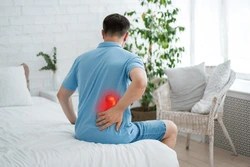Testosterone is a hormone with several functions. It is responsible for male reproductive development and promotes characteristics such as facial hair or a deeper voice It regulates sex drive and helps improve muscle mass, bone density, red blood cell count, and mental function.
Low T or Hypogonadism
 Low testosterone, also known as hypogonadism, is a condition in which the body doesn’t produce enough testosterone, the hormone essential for the development and maintenance of male characteristics and overall health.
Low testosterone, also known as hypogonadism, is a condition in which the body doesn’t produce enough testosterone, the hormone essential for the development and maintenance of male characteristics and overall health.
Low testosterone is relatively common, especially as men age. The prevalence increases with age, affecting approximately 20% of men over the age of 60, 30% of men over 70, and 50% of men over 80. However, it can also occur in younger men due to various medical conditions or lifestyle factors.
Some of the most common signs are a low sex drive and difficulty achieving and maintaining an erection (erectile dysfunction). There are also several medical conditions linked to ED like diabetes, thyroid disorders, high blood pressure, stress, and anxiety.
More of the common signs of low T include the following:
- Hair loss – both facial and body hair
- Less energy for activities and fatigue
- Decreased muscle mass
- Increased body fat
- Low sperm count
- Possible infertility
- Insomnia
- Mood and memory are affected
- Hot flashes
- Low blood count
Talk with board-certified urologist, Dr. Edward Sanchez, if you are experiencing any of these symptoms of low testosterone. We can help identify the problem and offer several solutions. If testosterone is needed, options such as gels, patches, injections, or slow release pellets can help you start feeling more like your normal self.
Lesser Known Symptoms of Low Testosterone
Be aware of some other signs of low T.
Reduced Bone Mineral Density
Men may not realize this until they experience a fracture. Low testosterone is linked to lower bone density and testosterone replacement therapy may be able to help this. It has been found to help improve bone density, especially with the lower spine and the hip.
Heart Attack and Stroke
No one is completely sure about the safety of testosterone replacement therapy (TRT), as studies remain mixed, but without testosterone, men can develop increased risk of cardiac events like a stroke and a heart attack. There is a correlation between low T and an increased rise in early deaths from heart problems.
Skin Issues
Testosterone plays a role in maintaining skin health by supporting oil production in the sebaceous glands. When testosterone levels are low, it can lead to decreased oil production, resulting in drier skin.
Nerve Pain and Numbness
It has been found that testosterone can repair damage to certain nerves within the body. The damage could be from diabetes, chemotherapies, physical injury, or chronic nerve issues. Researchers have looked at the role of testosterone in mitigating nerve damage. They discovered testosterone treatment can improve neuropathy and prevent numbness and pain. If you have diabetes and your nerve pain is getting worse, ask our board-certified urologist, Dr. Edward Sanchez, to test you for low T.
Difficulty Losing Weight
Testosterone replacement therapy (TRT) may help with weight loss, particularly in men with low testosterone levels. Testosterone influences body composition by promoting muscle mass and reducing fat mass. When testosterone levels are low, there may be an increase in fat accumulation, particularly around the abdomen. TRT can help reverse these effects by increasing muscle mass and reducing fat, which can contribute to weight loss.
In addition:
- Blood sugar levels were reduced
- Improved blood pressure
- Led to healthier blood lipids
Schedule a Low Testosterone Appointment in The Woodlands, TX
Contact our board-certified urologist, Dr. Edward Sanchez at (281) 351-5174 for a blood test at our urology clinic in The Woodlands and Northwest Houston if you are experiencing any of the above signs or lesser-known symptoms of low testosterone.
Sources:
Could you have low testosterone?: MedlinePlus Medical Encyclopedia
Low Testosterone (Low T): Causes, Symptoms & Treatment (clevelandclinic.org)
Low Testosterone (Low T): Symptoms, Causes, and More (healthline.com)
6 Strange Warning Signs of Low Testosterone (everydayhealth.com)
Morgante, G., Massaro, M. G., Di Sabatino, A., Cappelli, V., & De Leo, V. (2013). “Skin changes in hyperandrogenic states and low levels of androgens in women.” Gynecological Endocrinology, 29(1), 5-7. DOI: 10.3109/09513590.2012.724106.
Grossmann, M., & Matsumoto, A. M. (2017). “Hypogonadism and Testosterone Replacement Therapy in Elderly Men.” Endocrinology and Metabolism Clinics of North America, 42(2), 309-319. DOI: 10.1016/j.ecl.2017.01.001.
Nieschlag, E., & Behre, H. M. (2004). “Testosterone: Action, Deficiency, Substitution.” Cambridge University Press. DOI: 10.1017/CBO9780511544326.
Mulligan, T., Frick, M. F., Zuraw, Q. C., Stemhagen, A., & McWhirter, C. (2006). “Prevalence of hypogonadism in males aged at least 45 years: the HIM study.” International Journal of Clinical Practice, 60(7), 762-769. DOI: 10.1111/j.1742-1241.2006.00992.x.





